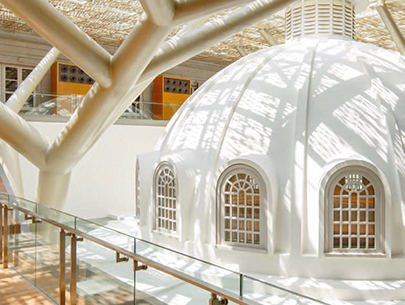Tracing transformations in the city
Olivia Poisson
Cities are constantly changing. Mechtild Widrich studies these changes closely and understands what they mean for the broader public.
It’s difficult to categorize Mechtild Widrich. The art historian and visual studies scholar holds a PhD from MIT, and researches the interface between art, architecture, and history. Working across these disciplines, she addresses complex questions relating to images, buildings, and public space. She often speaks about the city and the image – two concepts that together form her central research topic: the image of the city.
Iconic criticism has been the focus of eikones, a National Center of Competence in Research (NCCR) project at the University of Basel since 2005. Mechtild Widrich joined the center in 2013 as a postdoctoral fellow to work on the “Cities on the Move” research project, which looks at the relationship between the image and the city in art, architecture, and urbanism – an ideal constellation for the young researcher.
The disputed image of the city
Cities generate images. These images are not reserved exclusively for visitors to the city – as was the case for a long time – but are now mediated for the whole world to see. The kind of image and the message it sends are factors that are of political and national interest. It is therefore unsurprising that specific groups try to influence the image of a city through its architecture or art. The result? Numerous con tradictory images of a city that are circulated in the media and which shape public perception. “The image is not static – it is highly contested,” says Widrich.
This is the focus of Widrich’s research project entitled “Histories on the Move: The Nationalization of Global Art,” which looks at the relationship between national self-representation and the construction of national images through art.
One impressive example of a political image of the city is Singapore. Widrich’s research includes a study of the new National Gallery of Contemporary Art that is to be opened at the end of 2015. “By means of architectural projects such as the National Gallery and by exhibiting modern and contemporary art, Singapore is looking to actively shape its own image.” The museum is intended not only to make art accessible for local residents, but also to project a particular image on a global level.
An artificial art scene
In an official and transparent manner, Singapore has issued a so-called renaissance of the city. Its stated strategic goal is to become the new creative center in Southeast Asia. To this end, initiatives such as the Singapore Biennale and the new National Gallery are being launched. “The art scene is being created using a top-down approach here, which is intended to lead to a different image of Singapore in our heads.” Economic interests lie behind these developments – Singapore is a rich country and wishes to stay that way.
This is just the theory. “When you’re there, however, you realize that things are more complicated than that.” True, there is an abundance of talented artists, curators, and critics in Singapore, but this also means that they are highly critical and question the national interests, according to Widrich. “Many of them work subversively within the system, or call it into question, which results in counter-movements that push against the official strategic position.”
Widrich is conscious not to analyze any kind of status quo in her research: “I find things become exciting precisely when conflicting dynamics become visible in the image of the city. I’m interested in how these are formed, and how different social groups seek to influence these, as well as the various levels of reception. I think that investigating these dynamics in a social and political context is key to understanding the interrelation between local, national, and global representation mechanisms.”
Mechtild Widrich studied Art History at the University of Vienna, and Art and Architectural History at MIT, where she completed her PhD. After several years working as a freelance curator, she held a position as postdoctoral researcher and lecturer for Art and Architectural History at ETH Zurich between 2011 and 2013. In 2013, she joined the eikones project, the National Center of Competence in Research (NCCR) Iconic Criticism at the University of Basel. She has been working as Assistant Professor of Art History, Theory and Criticism at the School of the Art, Institute of Chicago, since May 2015.

